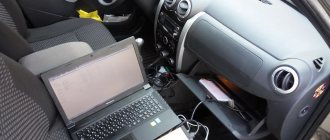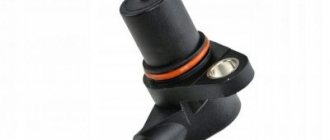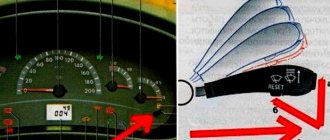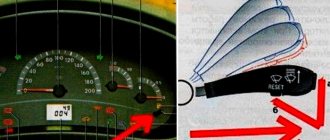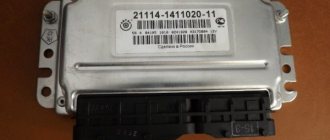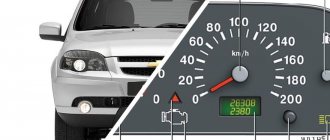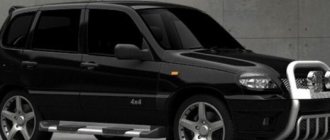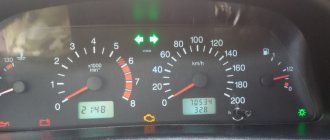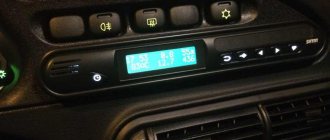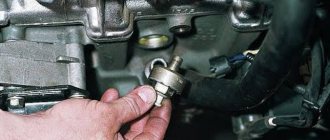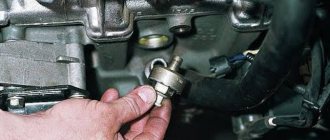Every modern car owner knows about the existence of an on-board computer, which can not only indicate the basic parameters of the operating mode (speed, consumption, temperature), but also recognize errors caused by various malfunctions. Unfortunately, Chevrolet Niva error codes cannot be deciphered without additional tables, since there are too many of them. Let's consider various diagnostic methods.
We receive the first signal about the presence of a malfunction using the indicator on the “Check-Engene” panel.
After turning on the ignition, all systems are tested, and if no errors are detected, this indicator goes out. Otherwise it remains burning. Specialized centers will quickly identify the error and not for free, but the Chevrolet Niva has a built-in on-board computer that can allow you to deal with the problem yourself.
Self-diagnosis
Without going into details of the operation of all electronics, we note that the functioning of all vehicle systems is “monitored” by an electronic control unit (ECU).
It receives information from numerous sensors. Like any computer, the ECU requires software called firmware. This firmware is capable of analyzing indicators received from sensors, comparing them with normal parameters, identifying errors and storing these errors in memory.
Carrying out self-diagnosis
In the Chevrolet Niva, as in some other cars of the VAZ family, some parameters can be displayed on the VDO dashboard. It is often called an integrated on-board computer.
Testing is started by first pressing the daily mileage reset button and simultaneously turning the ignition key.
All instrument needles begin to move, which indicates the beginning of the testing process. Pressing the same button once will cause the firmware version to appear on the display, and pressing it again will give us a reading called an error code.
Panel codes should not be confused with ECU codes, which are diagnosed by external devices.
| Error code | Decoding |
| 1 | Processor faults |
| 2 | No signal from the fuel level sensor |
| 4 | Increased voltage of the on-board network (exceeds 16 V) |
| 8 | Reduced voltage on-board network |
| 12 | Control indicator malfunction |
| 13 | No signal LAMDA probe |
| 14 | Increased coolant temperature |
| 5 | Reduced coolant temperature |
| 19 | Error from HF sensor |
| 21-22 | Error with TPS |
| 24 | Error from speed sensor |
| 27 — 28 | Incorrect CO potentiometer parameters |
| 23 — 25 | Error from intake air temperature sensor |
| 33 — 34 | Error from the MAF sensor |
| 35 | Error from sensor XX |
| 41 | Error from phase sensor |
| 42 | Ignition system malfunction |
| 43 | Error from knock sensor |
| 44 — 45 | Rich/lean fuel mixture |
| 49 | Loss of vacuum |
| 51 — 52 | ROM/RAM errors |
| 53 | No signal from CO potentiometer |
| 54 | No signal from the octane corrector |
| 55 | Load on the power unit |
The operation of the on-board computer cannot be called flawless, since many errors arise as a result of software failure. You have to reset the errors by holding down the daily mileage reset button in testing mode. This diagnostic method is not entirely convenient for the reason that the error code can be the result of the sum of two codes at the same time (10=8+2).
Replacing brushes or the generator itself
Current collection brushes wear out most often, so here is a description of how to do this job:
- Remove the negative terminal from the battery and disconnect the wires leading from the generator casing.
- Remove the protective cap from the terminals of the positive terminal of the wires. Unscrew the nut that secures the block to the generator block.
- Disconnect the spring clips and remove the black plastic cover.
- Unscrew the voltage regulator mountings with a Phillips screwdriver. Take it out along with the brushes.
- Disconnect the wires from it. Remove the assembly together with the fastening bar, take off the belt.
- Release the generator from the bracket by unscrewing all the mounting bolts.
The further plan of action depends on what you will change. If the brushes are very worn, they need to be replaced. If the current collectors are visually intact, then the reason may be in other parts of the generator. In most cases, car enthusiasts simply change it entirely.
Diagnostics with a scanner
The information in this section is quite extensive, since there are many types of scanners.
The basic principle of their operation is that all data, including errors, is transmitted from the ECU to a special diagnostic connector, which in a Chevrolet Niva is located on the driver's side under the steering wheel.
The scanner's job is to read and decode these messages.
Note that there are dealer scanners, that is, those that are designed for a given car. For Chevrolet Niva this is BC State.
It is inserted into the panel instead of the signaling device, and the information loop is prepared from the factory.
Universal scanners should be connected to the diagnostic connector. The most popular scanners today are models that allow you to transmit information via Bluetooth.
To do this, you need to install the appropriate application on your smartphone, for example, OpenDiag, and connect it to the scanner.
The program interface allows you not only to read the parameters, but also to manage some of them. You can also reset all errors from your smartphone. There are scanners with their own display. All error information in the form of codes is displayed on this display.
Bottom line
The most common Niva Chevrolet computer errors are found in 90% of car diagnostic cases. There are also a large number of rare failures that are not included in the list due to their low prevalence.
Read news about the new Niva
- The modernized Lada Niva Legend (4x4) 2021 was shown on the Internet
- Lada 4×4 Bronto - sales stopped, new details » Lada.Online - all the most interesting and useful about LADA cars
- Description of the instrument panel Lada 4×4 (VAZ 2121, 2131) » Lada.Online - all the most interesting and useful about LADA cars
- Chevrolet Niva gasoline consumption per 100 km
- Buy LADA (VAZ) 2131 (4×4) 2021 in Rostov-on-Don, low price for Lada 2131 (4×4) 2021 on the Avto.ru website
- Fuses Niva 21214 injector «
- The new large Lada 4×4 Niva “Bigster” 2021-2022 based on the Dacia Bigster was shown for the first time. The SUV has changed beyond recognition
- New Niva Chevrolet Lux 2021 - review of GLC equipment
Chevrolet Niva error codes
Errors transmitted through the diagnostic connector are displayed on an external device as a four-digit code. There are special tables that allow you to decipher these codes.
| Code | Explanation |
| P0102 | Low signal level of the mass air flow sensor (MAF). |
| P0103 | High signal level of the mass air flow sensor (MAF). |
| P0112 | low signal level of the intake manifold temperature sensor (ITM). |
| P0113 | High signal level of the intake manifold temperature sensor (IMT). |
| P0116 | The signal from the coolant temperature sensor (TTOZH) is out of the permissible range. |
| P0117 | Low signal level of the coolant temperature sensor (DTOZH). |
| P0118 | High signal level of the coolant temperature sensor (DTOZH). |
| P0122 | Low signal level of the throttle position sensor (TPS). |
| P0123 | High signal level of the throttle position sensor (TPS). |
| P0130 | Incorrect signal from oxygen sensor No. 1 to the converter. |
| P0131 | Low level signal from oxygen sensor No. 1 to the converter. |
| P0132 | High level signal from oxygen sensor No. 1 to the converter. |
| P0133 | Slow response to enrichment or depletion of oxygen sensor No. 1 to the converter. |
| P0134 | Lack of signal (open circuit) of oxygen sensor No. 1 to the converter. |
| P0135 | Malfunction of the oxygen sensor heater circuit No. 1 to the converter. |
| P0136 | Short circuit to ground in the N9 oxygen sensor circuit 2. |
| P0137 | Low level signal from oxygen sensor No. 2 after the converter. |
| P0138 | High level signal from oxygen sensor No. 2 after the converter. |
| P0140 | Lack of signal (open circuit) of oxygen sensor No. 2 after the converter. |
| P0141 | Malfunction of the heater circuit of the oxygen sensor No. 2 after the converter. |
| P0171 | The fuel supply system (fuel-air mixture) is too lean. |
| P0172 | The fuel system (air/fuel mixture) is too rich. |
| P0201 | Open circuit for controlling the injector of the 1st cylinder. |
| P0202 | Open circuit in the 2nd cylinder injector control circuit. |
| P0203 | Open circuit in the 3rd cylinder injector control circuit. |
| P0204 | Open circuit in the 4th cylinder injector control circuit. |
| P0261 | Short circuit to ground in the 1st cylinder injector control circuit. |
| P0262 | Short circuit to the source of the on-board network of the injector control circuit of the 1st cylinder. |
| P0264 | Short circuit to ground in the 2nd cylinder injector control circuit. |
| P0265 | Short circuit to the source of the on-board network of the injector control circuit of the 2nd cylinder. |
| P0267 | Short circuit to ground in the 3rd cylinder injector control circuit. |
| P0268 | Short circuit to the source of the on-board network of the injector control circuit of the 3rd cylinder. |
| P0270 | Short circuit to ground in the 4th cylinder injector control circuit. |
| P0271 | Short circuit to the source of the on-board network of the injector control circuit of the 4th cylinder. |
| P0300 | Random/multiple misfires detected. |
| P0301 | Misfire detected in cylinder N91. |
| P0302 | Misfire detected in cylinder N9 2. |
| P0303 | Misfire detected in cylinder N9 3. |
| P0304 | Misfire detected in cylinder N9 4. |
| P0327 | Low signal level of the knock sensor (DS). |
| P0328 | High signal level of the knock sensor (DS). |
| P0335 | There is no signal from the crankshaft position sensor (CPS). |
| P0336 | The crankshaft position sensor (CPS) signal is outside the permissible limits. |
| P0337 | Short circuit to ground in the crankshaft position sensor (CPS) circuit. |
| P0338 | Open circuit of the crankshaft position sensor (CPS). |
| P0340 | Malfunction of the camshaft position sensor (CPS) circuit. |
| P0342 | Low signal level of the camshaft position sensor (DPRV). |
| P0343 | High signal level of the camshaft position sensor (CPS). |
| P0422 | The efficiency of the neutralizer is below the permissible threshold. |
| P0441 | Incorrect air flow through the valve. |
| P0443 | The canister purge valve control circuit is faulty. |
| P0480 | Cooling fan N91 relay control circuit malfunction. |
| P0481 | Cooling fan N9 2 relay control circuit malfunction. |
| P0500 | Incorrect vehicle speed sensor signal. |
| P0503 | Intermittent signal from the vehicle speed sensor. |
| P0506 | Low idle speed (idle speed control blocked). |
| P0507 | High idle speed (idle speed control blocked). |
| P0560 | The on-board network voltage is below the system operability threshold. |
| P0562 | Reduced voltage of the on-board network. |
| P0563 | Increased voltage of the on-board network. |
| P0601 | Controller ROM checksum error. |
| P0603 | Error writing/reading external RAM of the controller. |
| P0604 | Error writing/reading internal RAM of the controller. |
| P0615 | Open starter relay control circuit. |
| P0616 | Short circuit to ground in the starter relay control circuit. |
| P0617 | Short circuit to the on-board supply source of the starter relay control circuit. |
| P1135 | Malfunction of the oxygen sensor heater circuit No. 1 to the converter. |
| P1140 | The signal from the mass air flow sensor (MAF) is incorrect; the measured load parameter differs from the calculated one. |
| P1141 | Malfunction of the heater circuit of the oxygen sensor No. 2 after the converter. |
| P1386 | The test pulse or controller knock channel integrator is out of tolerance. |
| P1410 | Short circuit to the on-board power source of the canister purge valve control circuit. |
| P1425 | Short circuit to ground in the canister purge valve control circuit. |
| P1426 | Open circuit for controlling the canister purge valve. |
| P1501 | Short circuit to ground in the electric fuel pump relay control circuit. |
| P1502 | Short circuit to the on-board supply source of the electric fuel pump relay control circuit. |
| P1509 | Overload of the idle air regulator (IAC) control circuit. |
| P1513 | Short circuit to ground in the idle air regulator (IAC) control circuit. |
| P1514 | Short circuit to the on-board power source (or open circuit) of the idle air regulator (IAC) control circuit. |
| P1541 | Open circuit in the electric fuel pump relay control circuit. |
| P1570 | There is no response from the car anti-theft system (ATS) or the circuit is open. |
| P1602 | Loss of on-board power supply voltage in the controller. |
| P1606 | Incorrect rough road sensor signal. |
| P1616 | Low level of rough road sensor signal. |
| P1617 | High level of rough road sensor signal. |
| P1640 | Error writing/reading internal flash RAM (EEPROM) of the controller. |
| P1689 | Incorrect code values in the controller fault memory. |
Lada 4×4 3d › logbook › the “check” light periodically lights up in the field 21214
Returning to the previous entry about the incomprehensible situation with the engine or brake pedal sensor... The burning “check engine” icon today, 08/20/2020, finally got to me and I decided to go for computer diagnostics of the car, check the Niva’s brains for possible errors. Previously, I drove around with my brother-in-law in his car those auto shops that I didn’t have time to visit in my Niva.
The new model brake pedal sensor I needed for the VAZ 21214 was not there either - all the sellers looked in amazement at the faulty sensor I was demonstrating, which I took with me, and unanimously turned their heads in different directions, saying the word “No”. Particularly advanced sellers, looking at the markings of the sensor, sent me to the foreign cars department, and my words that this sensor is being installed en masse on all domestic cars with an electronic gas pedal produced in 2021 were perceived with extreme distrust.
It seems like a sensor, like a sensor, if you believe the Internet, then it is produced by a plant in Arzamas, the sensor is marked 8200168238-B, on the other side there is an inscription in English “Renault 047”. On the official website in the city of Togliatti, its cost is set at 170 rubles. In Podolsk, they tried to sell me a sensor with the same marking, but made in Spain or France, for a minimum of 2200 and a maximum of 2900 rubles.
Everything is the same, only on expensive sensors there is additionally the inscription “Made in Spain” (the inscription is made in English). Having returned home, I got into my Niva and went to a car service center for diagnostics. My guess about the malfunction of the brake light switch off sensor or the simple “frog” turned out to be correct.
Also interesting: the Niva engine knocked
Having previously visited almost all the auto shops in my city in vain, I purchased the brake pedal sensor I needed at a car service center for just the negligible price of 350! rubles The “not original” sensor, completely black, made in France, is installed on some Renault cars. But then the most interesting thing began - the Niva’s engine worked intermittently, and continued to work.
The diagnostician constantly got errors “faulty injectors 1-2” and “misfire in cylinder 1.” During two hours of being in the service center, the spark plugs, the first and second injectors, spark plug wires, compression in all cylinders, and the ignition coil were checked for serviceability. I bought new ones with return conditions - an injector, an ignition coil, DENSO spark plugs (recommended at a car service center).
The spark plugs were original and they were black from carbon deposits. I must say that the electrician-diagnostician found it difficult to determine the malfunction of my car, because... The “misfire in cylinder 1” error appeared constantly, but periodically and disappeared when the engine was restarted. “DENSO” spark plugs were installed on my Niva, and the injector and ignition coil were returned to the seller.
Afterwards, the electrician went to “call a friend” in a nearby repair bay to get advice from other repairmen. In the next box there was a VAZ 2109 with similar symptoms, but with the error “misfire in the 3rd cylinder.” In total, I was told that my fault could not be detected (everything is normal) and they advised me to change the gas station where I constantly fill up my Niva .
I already own my third car, since 2006 I have refueled at only one, the only gas station in Podolsk, and I have never had problems with the engines of my cars. Although everything in our life always happens for the first time. At a car service center, I was advised to completely drain the gasoline from the gas tank and refuel at another gas station, drive around, look, and if the “CHECK” lights up again, then go for warranty repairs to the car dealership where I bought the car.
I just recently filled the tank full. Now there is 0.75 gasoline in the tank. I’m thinking about either pouring my gasoline into a canister, or driving around to produce gasoline, not paying attention to the burning “CHECK”... In terms of money: for two hours of work they charged me “divinely” 1,000 rubles, DENSO spark plugs 700 rubles, diagnostics with removal of the “CHECK” error 500 rubles. Total - 2200 rubles.
Computer diagnostics
The most complete diagnosis is possible with a computer or laptop. In order to use this method, you must purchase an adapter. This adapter performs two functions at once. It is an adapter from a K-line port to a USB port or to a COM port. It also acts as a decoder, which allows you to transmit signals from the ECU to the PC. You will also need to install the appropriate software on your laptop. There are a lot of free versions on the Internet. There are universal programs, as well as programs written for a specific car. After connecting to the computer, you will need to turn on the ignition and launch the program. The connection will happen automatically.
The interface of the computer program is very convenient and allows even an inexperienced user to navigate intuitively. All functionality can be divided into several sections. These are parameters, errors and settings. If the first two sections are informational, then using the third section you can control the vehicle systems.
Check Engine
When the ignition is turned on, the indicator should light up, so the ECM checks the serviceability of the lamp and control circuit. After starting the engine, the indicator should go out if the controller memory does not contain the conditions for turning it on.
If:
- The Check Engine light is constantly on - in this case, the driver is obliged to make the vehicle available to service technicians as soon as possible.
- A flashing Check Engine Light indicates a problem that can cause serious damage to the ECM (for example, a misfire can damage the catalytic converter).
To protect against random, short-term errors that may be caused by loss of contact in electrical connectors or unstable engine operation, the warning light turns on after a certain period of time after detecting a malfunction in the ECM. During this period, the on-board diagnostic system checks for a malfunction.
After eliminating the causes of the malfunction, the alarm will turn off after a certain delay time, during which the malfunction does not appear, and provided that there are no other fault codes in the controller’s memory that require turning on the alarm.
When clearing (deleting) fault codes from the controller’s memory using diagnostic equipment, the indicator goes off.
UAZ Patriot, Chevrolet Niva and Renault Duster: naval battle, or Russian landing in the Baltics
UAZ Patriot, Chevrolet Niva, Renault Duster.
Location: Khmelevka military training ground
Fourth day after start
The landing geometry is no good. The seat is ungodly tilted back, the distance to the steering wheel is crazy. Efforts on the pedals will help pump up your calves to the point of stone faster and more efficiently than the most merciless jog. And out of habit, you have to hammer the passes into two hands. But for the sake of the crazy smoothness that this device demonstrates on the black soil soggy after rain, for the sake of the confidence with which it storms the most inaccessible gullies, a lot can be forgiven. And yes, behind the wheel you really feel like a patriot.
With this thought, I stopped the BTR-82A manufactured by the Arzamas Machine-Building Plant, thanked my instructor and moved the hatch to look back: Patriot, Niva and Duster obediently followed. That's the news! Just recently, when the military showed us their test site, offering to climb onto the armor of an armored vehicle for a better view, I was absolutely sure that at least one of the vehicles would get stuck. And I had virtually no doubt that Renault would be the outsider. In fact, the Duster, shod with Amtel Cruise civilian tires, crawled forward almost more confidently than the Niva and Patriot. And he didn’t even hint at the need to forcibly lock the clutch or disable the traction control system.
Of course, the assault on the deepest mud is just one of several tests we have prepared for three popular all-terrain vehicles. But after a two-day drive from Moscow to Baltiysk and taking “mud baths,” I decided on my favorite one hundred percent. Duster! It’s just that my colleagues who spent more time with the Niva and UAZ tried to calm down my categoricalness, not skimping on praise for the original Russian technology.
At some point I gave in and decided not to rush to conclusions. The next day, Patriot, Niva and Duster had to be loaded on board and floated (in the slang of military sailors this is exactly what it sounds like) in the cargo compartment of a landing ship, and then landed on a treacherous sandy shore. Who knows if the “French” has enough geometry to not tear off the bumper when jumping off the ramp? Or maybe Renault will sit to its very bottom in the sand before others?
Location: M9 "Baltic" highway
First day of the journey
Riding in a convoy is a natural pleasure. Of course, if the company is well-coordinated. The person going first turns on the left turn signal and goes out to overtake, occupying the oncoming lane. If the road is visible hundreds of meters ahead, and the markings do not prohibit overtaking, the leader continues to move in the oncoming direction until the last car in the column completes the maneuver. A scheme that has been fine-tuned over the years. Fast, safe. Kirill Mileshkin, who led our procession in a Patriot, did everything carefully and correctly, but Vadim Kryuchkov, driving behind the wheel of a Niva, kept getting stuck behind some truck, “dropping” the pace the caravan had gained.
Don't think anything bad, Vadim is an excellent driver. It’s just that the ancient 80-horsepower engine is catastrophically not enough at highway speeds. Over the 14 years of life on the assembly line, everything possible was improved in the car: the transmission was persuaded not to whine under load, the old-fashioned interior of the biodesign era was given good seats, and the doors were taught to close the first time. But there is still no engine adequate to a suitably tuned chassis. And it’s unlikely to happen in this generation. In 2007, GM-AVTOVAZ attempted to launch mass production of the Niva with a 122-horsepower Opel engine and a five-speed Aisin manual transmission, but due to the high price by the standards of that time (from 550,000 rubles) and modest demand, everything ended in a limited batch of a thousand copies.
Even the heavy 128-horsepower Patriot is much faster and allows you to go into any attack without fear. However, there are other claims against him, no less significant. I'm talking about the ugly chassis: the Patriot, which as a result of permanent upgrades received a heated windshield and all seats, new door upholstery and a modern, albeit living multimedia system, has never learned to drive normally. He prowls shamelessly even on a flat road. And even without this nervousness, driving pleasure is questionable. The effort on the pedals and lever of the five-speed manual transmission is masculine, and the steering wheel, empty and weightless in the near-zero zone, does not quite adequately become heavier when turning at large angles. This forces you to constantly catch a tall car, steering endlessly. Do you remember how drivers in old black-and-white films turned the wheel non-stop for the sake of liveliness of the frame?
Needless to say, against the backdrop of such glaring shortcomings of two middle-aged Russian all-terrain vehicles, the Duster is perceived as ultra-modern and almost premium - despite the fact that it is already aged. This is an absolutely balanced, solid car. Quiet and fast - although by and large the pressure of the 114-horsepower naturally aspirated engine cannot be called convincing. Our complaints boil down to not the most comfortable seats with insufficient lumbar support (it is not adjustable) and the low location of the touchscreen of the multimedia system. But, you know, after a trip in the UAZ and Niva, you don’t dare to find fault with these little things. In general, the Duster is a clear leader on asphalt roads. I didn’t even notice how quickly the 620 km to the Latvian border melted away. Welcome to the European Union!
